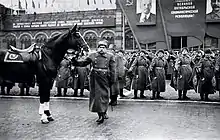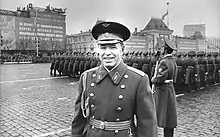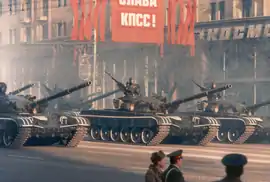List of October Revolution Parades in Moscow
The annual October Revolution Day Parade on 7 November (Russian: Военный Парад на 7 Ноября) on Moscow's Red Square was a military parade of the Moscow Military District of the Soviet Armed Forces that took place every year from 1919–1990 in honor of the anniversary of the Great October Socialist Revolution of 1917.[1] The annual parade marks the historic rebellion of the Petrograd Soviet, dominated and led by representatives from the Russian Social Democratic Labour Party (Bolsheviks), against the Russian Provisional Government led by Alexander Kerensky, thru the Soviet's military wing the Petrograd Military Revolutionary Committee on 6–7 November 1917 (N.S., 24–25 October O.S.).

History
On 1 May 1918, on International Workers' Day, the first parade of the Red Army took place on Khodynka Field.[2][3] Subsequently, many military parades were traditionally held, mainly on Red Square. At first, these events were held on the anniversary of the October Revolution. On 7 November 1919, a parade was held in honor of the second anniversary of the events of 1917. Columns of cadets, infantry, cavalry, and units, as well as horse-drawn artillery took part in the procession. Starting in 1922, parades began to be held twice a year: on 1 May and 7 November. There were no parades held from 1942-1944 due to occupation of Soviet territories by the German Wehrmacht. The last May Day parade took place in 1968, and the November parade ended in 1990.[4][5]
List of parades
1920s
There was no military parades held in 1920 and 1921. On 7 November 1922, a parade was held in honor of the fifth anniversary of the revolution, with the Chairman of the Revolutionary Military Council Leon Trotsky who inspected the parade and gave the keynote speech. It was the first to be held in the new Soviet era. In 1923, the first aerial filming of Moscow and Red Square was made and for the first time, artillery tractors participated in the parade. In 1924, the parade was opened by students of the Red Army Academy, who marched past Lenin's Mausoleum. The 1925 parade was not held due to the mourning period for Mikhail Frunze.
In 1927, Red Square hosted the huge parade that took place on the 10th anniversary of the revolution. A consolidated regiment of sailors from the Baltic Fleet and the Black Sea Fleet, as well as the North Caucasian Cavalry Regiment, the Joint State Political Directorate, and the People's Commissariat of Railways. There were no armored cars and tanks and due to inclement weather, the flypast over Red Square was canceled. Mikhail Kalinin was that year's parade inspector, and it would prove to be the last time the inspection was done on foot.
1930s
1930 would see the beginning of the wide armored columns passing thru Red Square provided by the men from the then Mechanized Brigade of the Moscow Military District.
In 1933, the newest additions to the parade were former partisans and bomber aircraft, plus the Vladimir Lenin All-Union Pioneer Organization and OSOAVIAKhIM. 1937 celebrated the twentieth anniversary of the revolution. The parade was commanded by Marshal of the Soviet Union Semyon Budyonny and inspected by Marshal Kliment Voroshilov. Training aircraft from the Zhukovsky Air Force Engineering Academy flew in visual formations "USSR" and the Roman numeral "XX" in the skies of the capital. It was the first ever Revolution Day parade ever to be started by the cadet drummers coming from the newly established Moscow Military Music College, which opened its doors that year.
In 1938, cadets of the Felix Dzerzhinsky Artillery Academy took part in the parade for the first time.
1941
The Moscow parade of 1941 was significant in that it was the sole parade ever to be held during the Great Patriotic War (known as the Second World War). Marshal Semyon Budyonny, the commandant of the Reserve Front, was assigned by Soviet leader Joseph Stalin to become the parade inspector that year, with Colonel General Pavel Artemyev commanding the formations present. Stalin would become the first Soviet leader to directly give the keynote address in a national parade.
1946-1966
In the post-war years, the selection of parade participants was carried out according to a strict criteria, including an age requirement of a soldier that being not older than 30 years and a height that is no less than 176 cm. In 1953, the tradition of receiving parades on horseback ended, with Marshal Nikolai Bulganin being the first to complete the inspection in an open car (specifically a ZIS-110B).[6] That same year, cadets of the Kiev Suvorov Military School in the Ukrainian Soviet Socialist Republic took part for the first time.[7] The first ever television broadcasts of the parade began in 1955. Intercontinental ballistic missiles were displayed for the first time at the ruby jubilee parade of 1957.[6] The practice of foreign leaders began in that year with Mao Zedong attending that year's parade as part of a state visit. In 1960, Che Guevara attended the parade that year.[8] Among the guests at the 46th anniversary parade in 1963 was Valentina Tereshkova.[9] The parade that year has one of the earliest records of the full parade to exist, as well as was the last parade attended by Nikita Khrushchev before he was deposed the following October.[10] In 1964, a new ICBM was unveiled.[11] For the first time, at the military parade in 1966, a mobile ground missile system equipped with an intercontinental ballistic missile (the prototype of the future Topol-M) was demonstrated.[12]
From 1965-1968, the Dzerzhinsky Division was represented by soldiers from the Urals and Siberia.[13]
1967
In November 1967 Minister of Defense Marshal Andrei Grechkov announced his gratitude and of the Ministry of Defence to all those who marched on Red Square in 1967 as the country marked the golden jubilee anniversary year of the Revolution and for the first time, together with the text of gratitude, they were presented with commemorative badges "Participant of the military parade".[2] Colour television broadcasts of the parade began that year in phrases, with the Moscow parade being seen only within the capital metropolitan area.
1968-1971
The parade began to have a live nationwide broadcast via satellite in 1969.
1972
The 1972 parade was the 100th parade ever to be held, marking the golden jubilee of the foundation of the Soviet Union. The Soviet Navy at the parade was represented by the cadets of the Black Sea Higher Naval School and the Leningrad Nakhimov Naval School. Another commemorative badge was also awarded in this year. A number of naval schools also had custom made badges made in honor of their participation in the celebrations, including the Higher Naval School of Radio Electronics named after Alexander Stepanovich Popov, and the Caspian Higher Naval School named after Sergei Kirov.[2]
1973-1976

The 1974 parade dedicated to the 57th anniversary was the last to feature heavy nuclear missiles such as ballistic missiles. Due to the rain that took place that day the parade of workers and athletes after the parade finale was cancelled.[14] Although the demonstrations on Red Square were cancelled, the demonstrations on Palace Square in Leningrad continued following the parade there.[15]
With 1975 marking the 30th anniversary of the Moscow Victory Parade of 1945, the Moscow Military Music College debuted what would be a 27-year tradition of leading the parades with its fanfare trumpeters and fifers, as well as its Turkish crescent and a pair of glockenspiels. The parade that year acted as the de facto Victory Day Parade for that jubilee year.[16]
Although military vehicles were present in 1976, there was no display of tanks.[17]
1977
The 1977 parade took place to commemorate the diamond jubilee anniversary of the October Revolution. The Soviet Communist Party General Secretary Leonid Brezhnev and Soviet Prime Minister Alexei Kosygin attended the parade, among other foreign leaders from Warsaw Pact and allied countries who decided to fly in for the celebrations.[18] As per tradition, 14 other Soviet Cities (including Leningrad) held their parades on this day. A folding stock version of the AK-47 notably appeared in the contingent from the Airborne troops.[19] This parade included the updated anthem of the Soviet Union.[20] The parade saw the return of military tanks after a two-year hiatus,[21] the highlight of which was the T-72 tank that was first publicly seen at this parade. The parade also featured a full return to the iconic armor columns and missiles in the second half of the parade.
1978-1986

Ethiopian leader Mengistu Haile Mariam was in attendance at the parade of 1980.[22] The 1981 parade was the first to introduce a new massed bands formation within Moscow. This included the full implementation of the sousaphone in the back row, as well as drummers added to the front line, spaced in between the fanfare trumpets. A new model ZiL limousine used for the inspection tour was also included.[23] The 1982 parade marked the 65th anniversary of the revolution, as well as the diamond jubilee of the USSR. It was the last parade attended by Leonid Brezhnev as he would die three days later. In 1983, Yuri Andropov (the Soviet leader at the time) did not attend the parade due to a sickness prior to the parade, which became the first parade not to be attended by a Soviet leader.[24][25] 1984 saw the participation of the Kaliningrad Higher Naval School.
1987
The 1987 parade celebrated the 70th anniversary of the October Revolution.[26] General Secretary Mikhail Gorbachev, other members of the Politburo and the heads of foreign states were present on the grandstand of Lenin's Mausoleum for the jubilee parade. It saw the participation of a Russian Revolution historical regiment (including a color guard consisting of 50 Civil War era colors as well soldiers in the uniforms of Red Guards and the former Imperial Russian Army) as well as a Great Patriotic War Regiment (led by a 12-member tri-services color guard of the Victory Banner).
1988 and 1989
From 1988 to 1990, on the Second Program of the State Television and Radio Broadcasting, it was broadcast with sign language translation. The 1989 parade was the first to have a drill routine by the massed bands take place
1990
The 1990 parade celebrated the 73rd anniversary of the revolution, being first and last parade attended by Mikhail Gorbachev in his position as President of the Soviet Union. Among those present were Premier Nikolai Ryzhkov, Russian leader Boris Yeltsin, and Moscow Mayor Gavriil Popov.[27] It is the only Soviet parade when the inspection of troops are held after the President's speech and anthem. It was also the last military parade to feature military equipment, something that would not be seen until the 2008 Moscow Victory Day Parade.[28][29][30][31] During the final parade, an assassination attempt was made on the life of President Gorbachev.[32]
List of parade leaders (since 1941)
| Year | Parade commander | Parade inspector | Year | Parade commander | Parade inspector |
|---|---|---|---|---|---|
| 1941 | Colonel General Pavel Artemyev | Marshal Semyon Budyonny | 1946 | Colonel General Pavel Artemyev | Marshal Leonid Govorov |
| 1947 | Marshal Kirill Meretskov | Marshal Nikolai Bulganin | 1948 | Marshal Kirill Meretskov | Marshal Semyon Timoshenko |
| 1949 | Colonel General Pavel Artemyev | Marshal Aleksandr Vasilevsky | 1950 | Colonel General Pavel Artemyev | Marshal Semyon Budyonny |
| 1951 | Colonel General Pavel Artemyev | Marshal Rodion Malinovsky | 1952 | Colonel General Pavel Artemyev | Marshal Semyon Timoshenko |
| 1953 | General of the Army Kirill Moskalenko | Marshal Nikolai Bulganin | 1954 | General of the Army Kirill Moskalenko | Marshal Nikolai Bulganin |
| 1955 | General of the Army Kirill Moskalenko | Marshal Georgy Zhukov | 1956 | General of the Army Kirill Moskalenko | Marshal Georgy Zhukov |
| 1957 | General of the Army Kirill Moskalenko | Marshal Rodion Malinovsky | 1958 | General of the Army Kirill Moskalenko | Marshal Rodion Malinovsky |
| 1959 | General of the Army Kirill Moskalenko | Marshal Rodion Malinovsky | 1960 | Мarshal Nikolay Krylov | Marshal Rodion Malinovsky |
| 1961 | Мarshal Nikolay Krylov | Marshal Rodion Malinovsky | 1962 | Мarshal Nikolay Krylov | Marshal Rodion Malinovsky |
| 1963 | General of the Army Afanasy Beloborodov | Marshal Rodion Malinovsky | 1964 | General of the Army Afanasy Beloborodov | Marshal Rodion Malinovsky |
| 1965 | General of the Army Afanasy Beloborodov | Marshal Rodion Malinovsky | 1966 | General of the Army Afanasy Beloborodov | Marshal Rodion Malinovsky |
| 1967 | Colonel General Yevgeny Ivanovsky | Marshal Andrei Grechko | 1968 | Colonel General Yevgeny Ivanovsky | Marshal Andrei Grechko |
| 1969 | Colonel General Yevgeny Ivanovsky | Marshal Andrei Grechko | 1970 | Colonel General Yevgeny Ivanovsky | Marshal Andrei Grechko |
| 1971 | Colonel General Yevgeny Ivanovsky | Marshal Andrei Grechko | 1972 | Colonel General Vladimir Govorov | Marshal Andrei Grechko |
| 1973 | Colonel General Vladimir Govorov | Marshal Andrei Grechko | 1974 | Colonel General Vladimir Govorov | Marshal Andrei Grechko |
| 1975 | Colonel General Vladimir Govorov | Marshal Andrei Grechko | 1976 | Colonel General Vladimir Govorov | Marshal Dmitry Ustinov |
| 1977 | Colonel General Vladimir Govorov | Marshal Dmitry Ustinov | 1978 | Colonel General Vladimir Govorov | Marshal Dmitry Ustinov |
| 1979 | Colonel General Vladimir Govorov | Marshal Dmitry Ustinov | 1980 | Colonel General Vladimir Govorov | Marshal Dmitry Ustinov |
| 1981 | General of the Army Petr Lushev | Marshal Dmitry Ustinov | 1982 | General of the Army Petr Lushev | Marshal Dmitry Ustinov |
| 1983 | General of the Army Petr Lushev | Marshal Dmitry Ustinov | 1984 | General of the Army Petr Lushev | Marshal Sergey Sokolov |
| 1985 | Colonel General Vladimir Arkhipov | Marshal Sergey Sokolov | 1986 | Colonel General Vladimir Arkhipov | General of the Army Petr Lushev |
| 1987 | Colonel General Vladimir Arkhipov | Marshal Dmitry Yazov | 1988 | General of the Army Konstantin Kochetov | Marshal Dmitry Yazov |
| 1989 | Colonel General Nikolai Kalinin | Marshal Dmitry Yazov | 1990 | Colonel General Nikolai Kalinin | Marshal Dmitry Yazov |
See also
References
- "Юбилеи и годовщины". ancbs.ucoz.ru. Retrieved 2020-07-25.
- "Нагрудные знаки участникам московских парадов". izhig.ru. Retrieved 2020-07-28.
- "ПО БРУСЧАТКЕ КРАСНОЙ ПЛОЩАДИ". history.ric.mil.ru. Retrieved 2020-07-30.
- На Красной площади прошел Парад Победы
- История парадов на Красной площади: цифры и факты
- История военных парадов 1941-2012 годов (in Russian), retrieved 2020-07-30
- "Киевское суворовское военное училище". cadethistory.ru. Retrieved 2020-07-30.
- https://www.youtube.com/watch?v=NSUpUEfhXcc
- "Парад и демонстрация 7 ноября 1963 года". pro.nostalgiatv.ru. Retrieved 2020-07-24.
- RedSamurai84 (2016-05-09), Soviet October Revolution Parade, 1963 Парад 7 Ноября, retrieved 2016-10-09
- Haines, Gerald K.; Leggett, Robert E. (2003). Watching the Bear: Essays on CIA's Analysis of the Soviet Union. Center for the Study of Intelligence, Central Intelligence Agency.
- Самые грандиозные парады на Красной площади. rg.ru
- http://tramuk.ru/novosti/obshchestvo/2967-voennyj-parad-na-krasnoj-ploshchadi-osobyj-simvol-rossii.html
- "There would also be no demonstration of workers this year due to the rainy weather". YouTube.
- https://www.vl.ru/tv/cast/630/1721959
- "Интересные факты о Парадах Победы :: Новости - RuFox". Новости РуФокс. Retrieved 2020-07-30.
- HD Soviet October Revolution Parade, 1976 Part I Парад 7 Ноября, retrieved 2020-04-25
- https://www.nytimes.com/1977/11/08/archives/soviet-marks-revolution-fete-with-a-major-parade.html
- "Infantry Magazine". 1980.
- RedSamurai84 (2016-05-11), Soviet October Revolution Parade, 1977 Part II Парад 7 Ноября, retrieved 2017-01-16
- http://mospravda.ru/2020/06/23/155943/
- https://m.youtube.com/watch?v=Ip1IZhaNy4o
- RedSamurai84 (2016-05-19), HD Soviet October Revolution Parade, 1981 Парад 7 Ноября, retrieved 2016-09-25
- Times, Serge Schmemann, Special To The New York (1983-11-08). "ANDROPOV MISSES MOSCOW PARADE, STIRRING RUMORS". The New York Times. ISSN 0362-4331. Retrieved 2017-01-27.
- Schmidt-Häuer, Christian (1986-01-01). Gorbachev: The Path to Power. I.B.Tauris. ISBN 9781850430155.
- "Парад и демонстрация на Красной площади в Москве 7 ноября 1987 года ( начало)". pro.nostalgiatv.ru. Retrieved 2020-07-12.
- "Фильм 7 ноября 1990 года. Москва.. (1990)". www.net-film.ru. Retrieved 2020-07-22.
- ""Тополь-М" провезут по Красной площади 9 мая". Ведомости (in Russian). Retrieved 2020-07-22.
- "История парадов на Красной площади 7 ноября. Досье". ТАСС. Retrieved 2020-07-22.
- "История парадов в Москве". vvprf.ru (in Russian). Retrieved 2020-07-22.
- Впервые с 1990 года на Параде Победы военная техника пройдет у стен Кремля. Новости. Первый канал (in Russian), retrieved 2020-07-22
- Levkovich, Yevgeny (2017-02-16). "The last Soviet terrorist: The man who tried to assassinate Gorbachev". Russia Beyond The Headlines. Retrieved 2017-03-30.